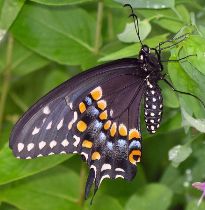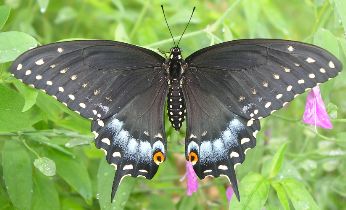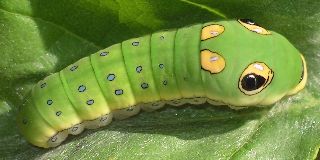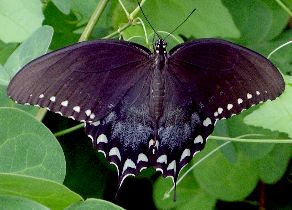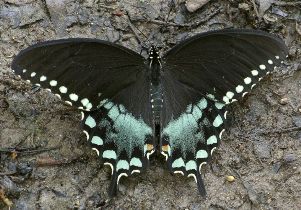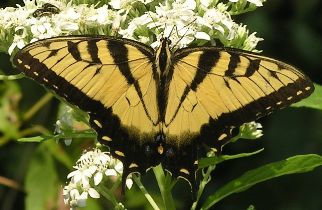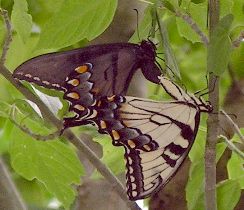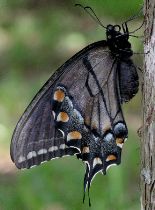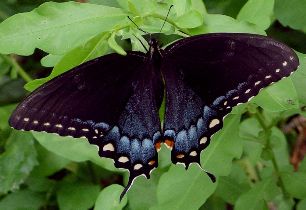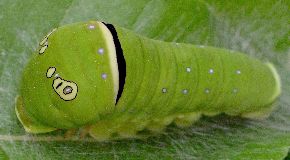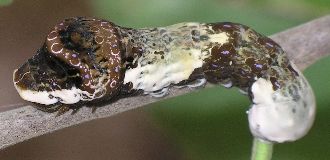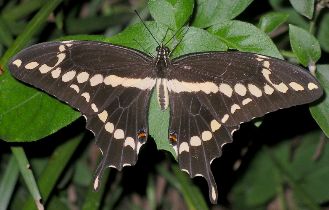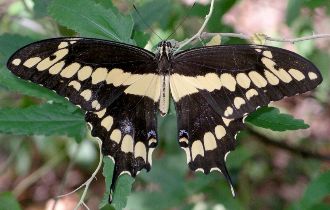
| Papilionidae ~ Swallowtails |
page 1 ![]() page 2
page 2
|
Adult male Black Swallowtails have a series of gold spots that form diagonal bands on the tops of their wings, but females are mostly black with prominent blue markings on their hind wings. They are thought to mimic the poisonous Pipevine Swallowtails and thereby gain some protection from predators. The undersides of the hind wings of both species are quite similar at a glance.
Yet another black mimic of the Pipevine is the Spicebush Swallowtail (Papilio troilus). As the name implies, the host plant for this butterfly is Spicebush (Lindera benzoin). The young caterpillars look like bird droppings, but the older ones become green with two prominent eyespots. The larvae hide in folded leaves.
The adult females are mostly black, with barely a hint of blue on the hind wings, while the males have an aqua colored wash to theirs.
There are two tiger swallowtails found in our area. The Eastern Tiger Swallowtail (Papilio glaucus) is the most commonly seen big yellow swallowtail. While both males and females can be yellow, only the males are guaranteed to be that color. The females may also be black, and the black versions come in varying degrees of saturation, often showing hints of the stripes, much like the spots on black leopards show in their pelt. The black females are, like a number of other swallowtails, mimics of the distasteful Pipevine Swallowtail. I've heard that male Tiger Swallowtails prefer yellow females but the black ones have added protection from bird predation, which accounts for why both forms exist. However, I've actually seen more mating and courting mixed pairs. I suspect the males of this species are like many males in general: they aren't all that particular when a willing partner is around.
The Two-tailed Swallowtail (Papilio multicaudata) is not particularly common but the large adults are hard to miss when they fly past. The caterpillars feed on Wafer Ash (Ptelea trifoliata). The young instars resemble bird droppings, as is common to swallowtails, but the older ones turn green and have startling eyespots.
Giant Swallowtail (Papilio cresphontes) larvae feed on both Wafer Ash (Ptelea trifoliata) and cultivated citrus plants, giving them another common name: Orange Dog. In areas where citrus crops are grown, the caterpillars can be a nuisance. The larvae are bird dropping mimics, and retain this coloration into maturity. Because of their camouflage, they can often be found feeding right out in the open on their host plants. True to its name, the Giant Swallowtail is big. It is a dark brown or almost black color with well-defined yellow markings. The undersides of the wings are mostly yellow. Rather common in our area, these butterflies are usually seen as they feed at flowers. As with many swallowtails, they tend to flutter constantly, making it hard to get a good look at them, let alone a good photo. Another habit of swallowtails, though, is their evening roosting behavior. I've found that our yard is attractive to both Tiger and Giant Swallowtails when they are looking for a place to spend the night. Once they have settled in a heavily vegetated area, usually about 3-4 feet off the ground, they can usually be approached quite closely and will stay put. They are often there in the morning, waiting for the sun to rise high enough before they depart.
One other species that shows up here is the Thoas Swallowtail (Papilio thoas). This is a very tricky identification because it looks almost identical to the Giant. The only place I've been able to see a good number of Thoas Swallowtails is in the Butterfly Rainforest exhibit on the campus of the University of Florida in Gainesville. After comparing lots of photos (and discussing it with the experts in Florida), the only good identification feature seems to be the width of the yellow band that cuts through the middle of the butterfly across the upper wings and into the base of the lower. On Thoas Swallowtails, the yellow area on the lower wings is significantly wider as it reaches the inner area towards the body. Giant Swallowtails always have a narrow band at that point. All the other yellow markings vary so much that there seem to be no reliable distinctions between the species. I've only photographed one specimen in Austin that I think has a good chance of being a Thoas (see accompanying photo), but I wouldn't bet on it. |
page 1 ![]() page 2
page 2
![]()
